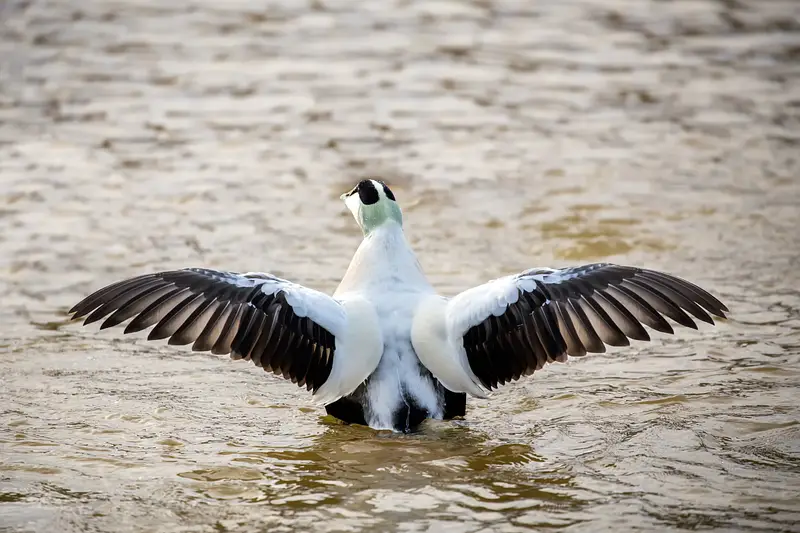About Common Eider
The Common Eider (Somateria mollissima) is the largest duck in the Northern Hemisphere, known for its striking plumage and impressive diving abilities. This sea duck is famous for its soft down feathers, which are highly prized for their insulation properties. Common Eiders are primarily found along the northern coasts of North America and Europe, often seen in large, sociable flocks. Their presence in coastal waters and distinctive appearance make them a favorite among bird enthusiasts.

Identification
Common Eiders are easily recognizable by their large size and distinctive plumage. Males have striking black and white plumage with a greenish nape and a prominent white patch on their backs. Females are more camouflaged, with mottled brown plumage that blends well with their nesting environment. Both sexes have a strong, wedge-shaped bill and a distinctive profile that makes them easy to identify among sea ducks.
Breeding
Common Eiders breed in the Arctic and sub-Arctic regions, selecting coastal islands and tundra areas for nesting. The female builds a nest lined with her own down feathers, which provides excellent insulation for the eggs. She typically lays a clutch of 4-6 eggs and is solely responsible for incubation and care of the ducklings.
Behavior
Common Eiders are also known for their distinctive vocalizations. Males produce a soft, cooing call, while females emit a more guttural sound. These vocalizations are important for communication within flocks and between mates, especially during the breeding season. Common Eiders also display strong site fidelity, often returning to the same breeding and wintering areas year after year. This behavior ensures that they utilize familiar and proven habitats that provide the necessary resources for survival and reproduction. During the breeding season, females show a high degree of philopatry, returning to their natal colonies to nest.
Habitat
Common Eiders inhabit coastal marine environments, preferring rocky shores, islands, and estuaries. During the breeding season, they nest in the Arctic and sub-Arctic regions, utilizing coastal islands and tundra areas. In the winter, they migrate to more temperate coastal waters, often gathering in sheltered bays and estuaries where they can find ample food and protection from harsh weather.
Migration
Common Eiders are long-distance migrants, traveling between their breeding grounds in the Arctic and sub-Arctic regions to their wintering areas along the coasts of North America. They migrate in large, cohesive flocks, often flying low over the water. Their migratory routes can cover thousands of miles, showcasing their endurance and navigational skills.
No Data Found
How many days tracked
Lorem ipsum dolor sit amet, consectetur adipiscing elit. Ut elit tellus, luctus nec ullamcorper mattis, pulvinar dapibus leo.
Where are they now?
Lorem ipsum dolor sit amet, consectetur adipiscing elit. Ut elit tellus, luctus nec ullamcorper mattis, pulvinar dapibus leo.
No Data Found
No Data Found
Total Number of Data Points for Common Eider
Lorem ipsum dolor sit amet, consectetur adipiscing elit. Ut elit tellus, luctus nec ullamcorper mattis, pulvinar dapibus leo.
Start and End Date Tracking of Common Eider
Lorem ipsum dolor sit amet, consectetur adipiscing elit. Ut elit tellus, luctus nec ullamcorper mattis, pulvinar dapibus leo.
No Data Found
Overall Data from the Center
This is historical data from various sources. This data is available in its full form on our Duck Map in an easily visualizable format.
